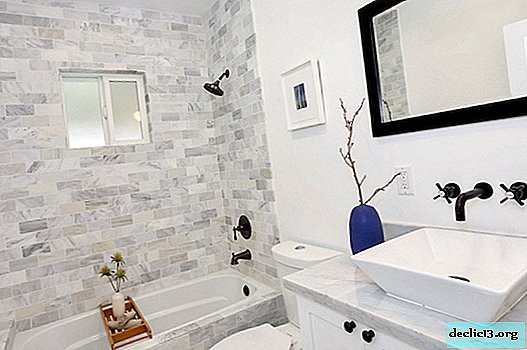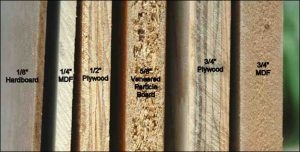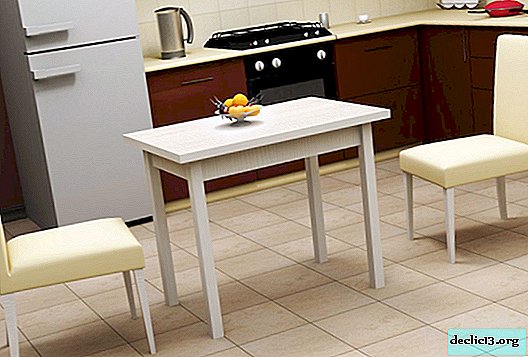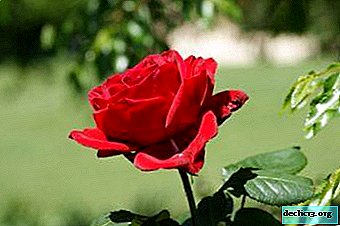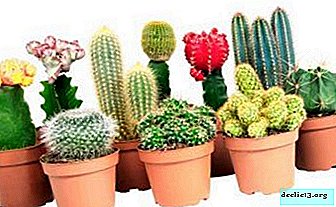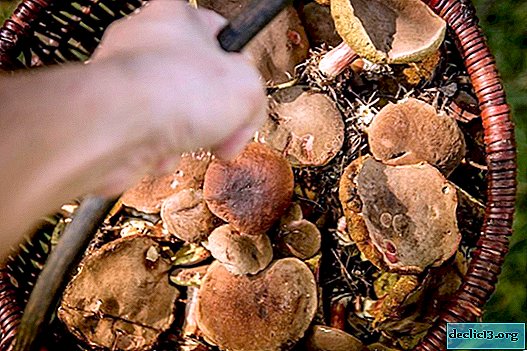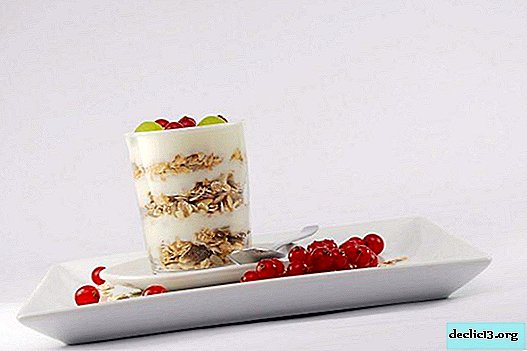Bright and unpretentious stonecrop caustic: description and photo of varieties, care and reproduction
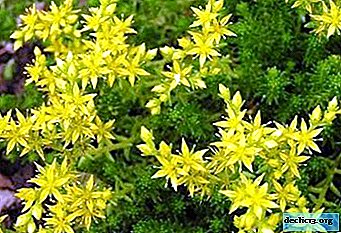
Sempervivum, rabbit cabbage, violin, hernial grass, fever grass, living water, whip, stone pepper, bird mushroom, God's body - all these names in the people have given one plant - stonecrop.
It has received such attention due to its wide distribution and unique healing properties.
In more detail about the characteristics, cultivation of sedum caustic or "Yellow Rose" and how this plant looks in the photo, we will tell further.
Description and characteristics of the plant
Why does it have such a name?
The name of the genus Sedum comes from the Latin "sedo", which means "sit", meaning the small size of the plant.There is also a version that "sedo" means to "subside", giving a reference to the painkiller properties of the plant.
 The Russian name of the genus is due to the ability of stonecrop to cleanse the skin from boils, eczema, warts. Initially, the name was pronounced as "purifications", but it was the "sedum" option that took root.
The Russian name of the genus is due to the ability of stonecrop to cleanse the skin from boils, eczema, warts. Initially, the name was pronounced as "purifications", but it was the "sedum" option that took root.
The specific name "caustic" this plant received due to the toxicity of the juice containing a whole set of alkaloids. Getting in pure form on the skin, it can cause ulcers.
For the same reason cattle bypasses caustic stonecrop sidewithout eating its bitter scorching shoots. Also, this type of sedum may be called the "Yellow Rose."
Botanical characteristics and homeland
This is a typical representative of the genus Sedum. The birthplace of caustic sedum is the arid foothills of the Caucasus and Asia Minor. It grows in nature in the European part of Russia, Ciscaucasia, Western Siberia, as well as in all Central Russian regions. It prefers dry places on sandy soil, edges, wastelands, embankments and rocky slopes.
Appearance
Sedum "Yellow Rose" or stonecrop - a small, multi-stemmed, herbaceous plant reaching a height of up to 10 cm, fleshy leaves, egg-shaped, yellow flowers with five sepals (bright as lights) and petals are located on spreading inflorescences.
In nature, form glades. Numerous plants gather in dense low bushes. The rhizome of Sedum is powerful and branched, which allows the plant to produce maximum moisture.
Is it easy to grow?
The flowering period is from late spring to mid summer. Growing stonecrop is not at all difficult. It is able to grow in the most adverse conditions. The only requirement for him is a sufficient amount of sunlight.
Healing properties
- In medical practice, the infusion of the herb of the plant is used to exert an exciting and tonic effect on the nervous system, stimulate respiration, and increase intestinal motility.
- It has a strong diuretic effect.
- It is used to treat hypotension.
Extracts of caustic scum activate the body's defenses, have anti-inflammatory and stimulating effects, accelerate metabolic processes.
Sedum acre varieties and their photos
Aureum

The leaves of the plant are small, fleshy, juicy, elongated elliptical in shape. From light green to green-yellow. The golden color of the foliage is especially bright in the spring before flowering. Bright yellow flowers collected in thyroid inflorescences at the ends of non-deciduous flowering shoots.
The flowering period is from May to July. At this time, the flowers completely cover the plant.In the middle lane in winter it requires dry shelter; in its absence it freezes out after 1-2 years.
Elegans

Belongs to the genus Petrosedum. Forms glades, about 10 cm high. The leaves of the plant can be green, bluish, sometimes purple. Yellow flowers on peduncles 20-30 cm high.
Characteristic features are rapid growth and the need for regular watering.Minus

Minus forms rugs, 5-10 cm high. Small fleshy leaves of a cylindrical shape, acquiring a pink color in the bright sun, are located on numerous pinkish-red lying stems. The plant is frost-resistant.
Care
| Lighting | A very important factor for cleaning. Only with sufficient lighting is it possible for the plant to bloom and maintain a bright foliage color. If the lighting is not enough, the stonecrop can stretch, losing its decorative effect. If the plant is contained in the house, it is recommended to regularly wipe the leaves from dust so that it does not delay the flow of light, if stonecrop grows on the site, you need to make sure that the dry foliage from the trees does not remain on it. This plant will not be able to break through the layer of decline in spring. |
| Temperature | Stonecrop does not require strict adherence to the temperature regime; it is comfortable both in warmth and in coolness. The optimum temperature is from 8 to 26 degrees in the summer. With proper care, it can withstand higher temperatures. Winter is a period of rest for stonecrop. At this time, the required temperature for its content is 8-10 degrees. If the room is too warm, the shoots will stretch and deform. |
| Location | It is best to place the stonecrop at home on the windowsills of the southern windows, remembering the extreme photophilousness of this plant. But if it will be direct sunlight with a tightly closed window, then the plant will simply wither. It is best to move the stonecrop to the street during the summer months, if this is not possible, then it is necessary to ensure the flow of fresh air into the room. |
| Watering | Stonecrop refers to succulents, so abundant watering is contraindicated. Waterlogged soil is a direct path to plant death, especially in winter. In spring and summer, watering is performed as the top layer of the substrate dries. In winter, stonecrop is watered once every four weeks. The plant does not need spraying, you can only wipe the leaves in order to remove dust. |
| Air humidity | It is not necessary to take special moisturizing measures for cleaning. Due to the nature of its natural growth, it tolerates dry air well. |
| Top dressing | Feeding stonecrop is recommended only in the spring-summer period. Fertilizers for cacti. In the autumn-winter period, fertilizers do not need to be introduced. |
| The soil | A special ground for cacti from a flower shop is suitable for stonecrop, but you can prepare the substrate yourself by mixing turf and sheet soil, brick chips and sand in a ratio of 2: 2: 1: 2. You can add some charcoal. Good drainage is also important for the plant. |
| Pruning | After flowering ends, stonecrops need to cut flower stalks so that the plant does not deplete. |
Breeding
Cuttings
The vegetative method is very popular for stonecrop. It is best to carry out the cuttings in July, the time remaining until the fall is just enough for the cuttings to take root and strengthen properly.Before planting the cuttings, they should be dried in a cool place.. After planting, watering is minimized in order to compact the soil between plants. Also, young plants need shading, unlike adults, they are not yet able to withstand exposure to bright sunlight.
Seeds
 Reproduction of stonecrop by seeds is possible, but this is not the most popular method, due to its problematic nature. At home, the seeds are sown in the spring, in the open ground the seeds are laid before winter. If spring breeding is planned, the seeds must undergo a stratification procedure, that is, they artificially need to create winter conditions.
Reproduction of stonecrop by seeds is possible, but this is not the most popular method, due to its problematic nature. At home, the seeds are sown in the spring, in the open ground the seeds are laid before winter. If spring breeding is planned, the seeds must undergo a stratification procedure, that is, they artificially need to create winter conditions.
Step by step propagation of stonecrop by seeds is as follows:
- Seeds are sown on the soil in a small container.
- The earth is getting wet.
- The container with crops needs to be covered with glass or film, you can just put it in a bag and tie it.
- Place the container on the bottom shelf of the refrigerator. It is important to keep the temperature within 5-7 degrees.
- Under such conditions, the seeds are kept for two weeks. At this time, daily you need to remove the film and ventilate the crops, as well as spray the soil.
- After the end of the artificial winter period, the seed tank moves to room conditions. If you observe a temperature of 18-20 degrees, seedlings will appear in two to four weeks.
- The seedlings that have appeared are very tiny and it is important to track the appearance of the first two leaves. At this time, you need to pick.
- If it is planned to determine the received planting material in open ground, then it is better to manipulate the seeds in March, so that already in May it would be possible to plant stonecrop in the open.
Bush division
For this method of reproduction, an adult, at least 4 years old, plant is required.
- The bush is divided into several parts, each of which must have both roots and buds from which new shoots will grow.
- Cut points are treated with fungicide.
- For several hours, parts of the plant are dried in a cool dark place, then sedum is planted in the ground.
Landing
 This plant does not show special soil requirements, a ready-made substrate for succulents is quite suitable. When planting stonecrop in pots, the sequence of operations is as follows:
This plant does not show special soil requirements, a ready-made substrate for succulents is quite suitable. When planting stonecrop in pots, the sequence of operations is as follows:
- Sowing material is purchased in a specialized store, the seeds are soaked in a root stimulant.
- Small pots, approximately 0.2 l. Fill the substrate and moisturize it.
- Treated seeds are dried and sown in pots. The peculiarity of stonecrop seeds is their very small size, therefore, due to the impossibility of piece planting, it is recommended to place the seeds closer to the edge of the pot, so that during subsequent diving, neighboring seedlings will not be damaged.
- Crops are covered with a film and placed in a room with room temperature. Crops are regularly ventilated and sprayed from the spray gun.
- Emerging seedlings are treated with a growth stimulator.
- When two full leaves appear, the plant is dived into pots with a diameter of 8-10 cm.
- Further care consists in loosening the soil and watering.If in the future it is planned to plant stonecrop in open ground, the plant must be hardened, taking it to fresh air.
Possible difficulties
- Slow growth.
It is usually characteristic of the period after transplantation. The fact is that at this time stonecrop is actively building up the root system or gaining strength for flowering, the growth of the aboveground mass is suspended.
- Pests attack flowers.
For the most part, pests for caustic sedum are not dangerous, due to the toxicity of the juice of its leaves, but attacks on flowers do occur. The method of struggle is simple - you need to mechanically remove the damaged parts of the plant.
Caustic stonecrop - a worthy alternative to flowering groundcover, requiring careful care. Unpretentious and highly decorative, every year he successfully gains the sympathy of gardeners.
Interesting video
We offer you to watch a video about sedum caustic:





